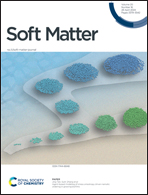The effect of aromatic side chains on the dilational rheological properties of N-acyltaurate amphiphiles at water–decane interfaces
Abstract
To elucidate the effect of aromatic side chains on dilational rheological properties of N-acyltaurate amphiphiles at the decane–water interface, the interfacial rheological properties of sodium N-2-(2-naphthoxy)-tetradecanoyltaurinate (12+N-T) and sodium N-2-(p-butylphenoxy)-tetradecanoyltaurinate (12+4B-T) were investigated utilizing the drop shape analysis method. The effects of adsorption time, interfacial pressure, oscillating frequency, and bulk concentration on the interfacial dilational modulus and phase angle were explored. The results show that the 12+4B-T molecule with a longer hydrophobic chain shows a higher ability for reducing the interfacial tension (IFT). In addition, the interfacial films of both 12+N-T and 12+4B-T are dominated by diffusion exchange at high concentrations. The rigidity of molecules controls the diffusion exchange at low concentrations, while the molecular hydrodynamic radius determines the diffusion exchange at high concentrations. Thus, at low concentrations, the stronger intermolecular interaction between 12+4B-T molecules results in higher dilational modulus values than 12+N-T. When approaching the CMC (critical micelle concentration) value, the rapid diffusion exchange of 12+4B-T between the sublayer micelles and the interface causes a significant decrease in the dilational modulus, while the relatively rigid structure of 12+N-T enables a higher dilational modulus than 12+4B-T. What's more, the longer hydrophobic chain allows 12+4B-T molecules to escape from the interface more easily, resulting in a higher phase angle at low concentrations. However, the diffusion exchange of 12+4B-T is slower than that of 12+N-T, which results in lower phase angles for 12+4B-T than 12+N-T at high concentrations. In general, the introduction of a rigid naphthalene ring in the molecular structure gives the interfacial film greater strength at high concentration. The research results in this paper provide a new technique for the strength regulation of interfacial surfactant adsorption films.



 Please wait while we load your content...
Please wait while we load your content...